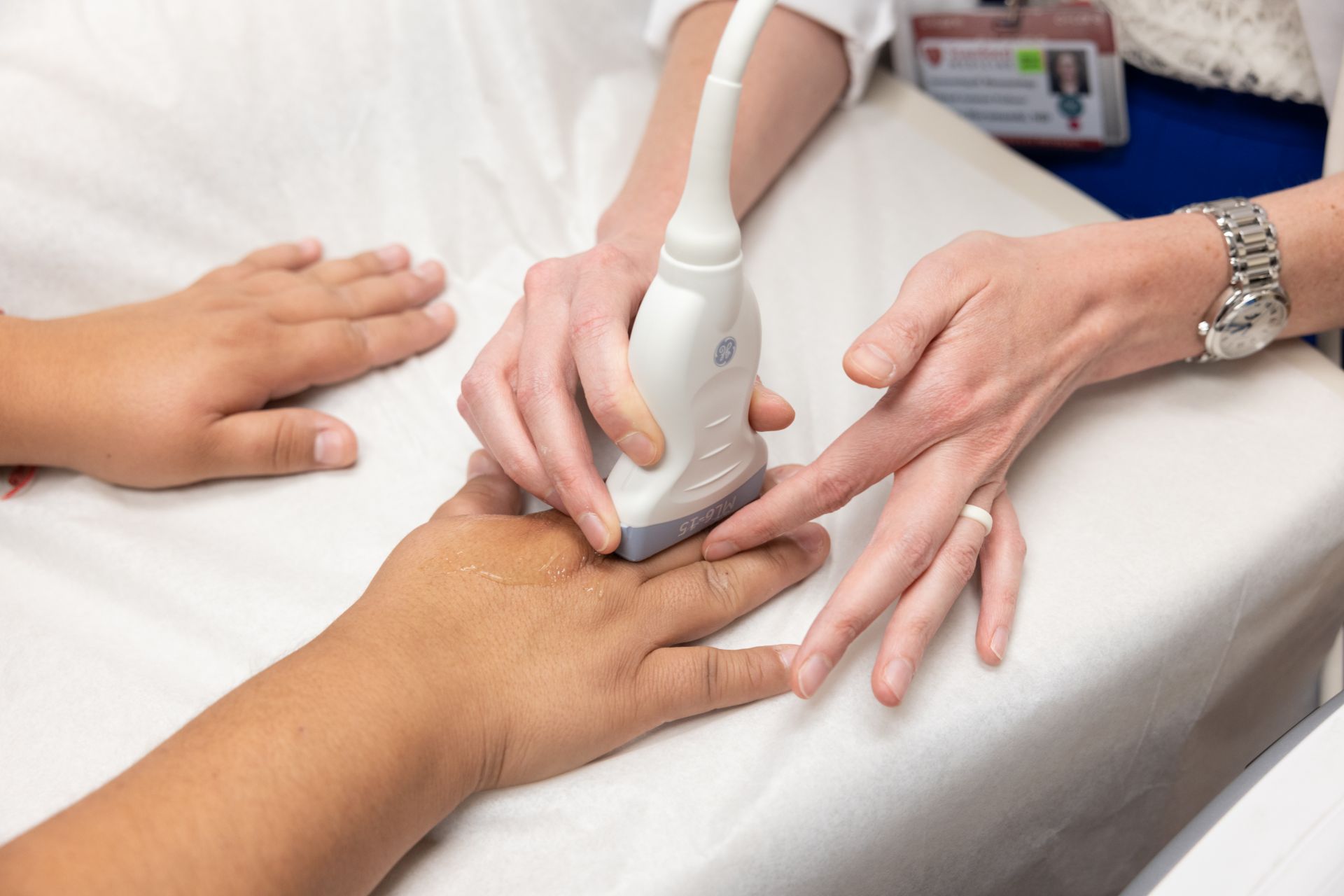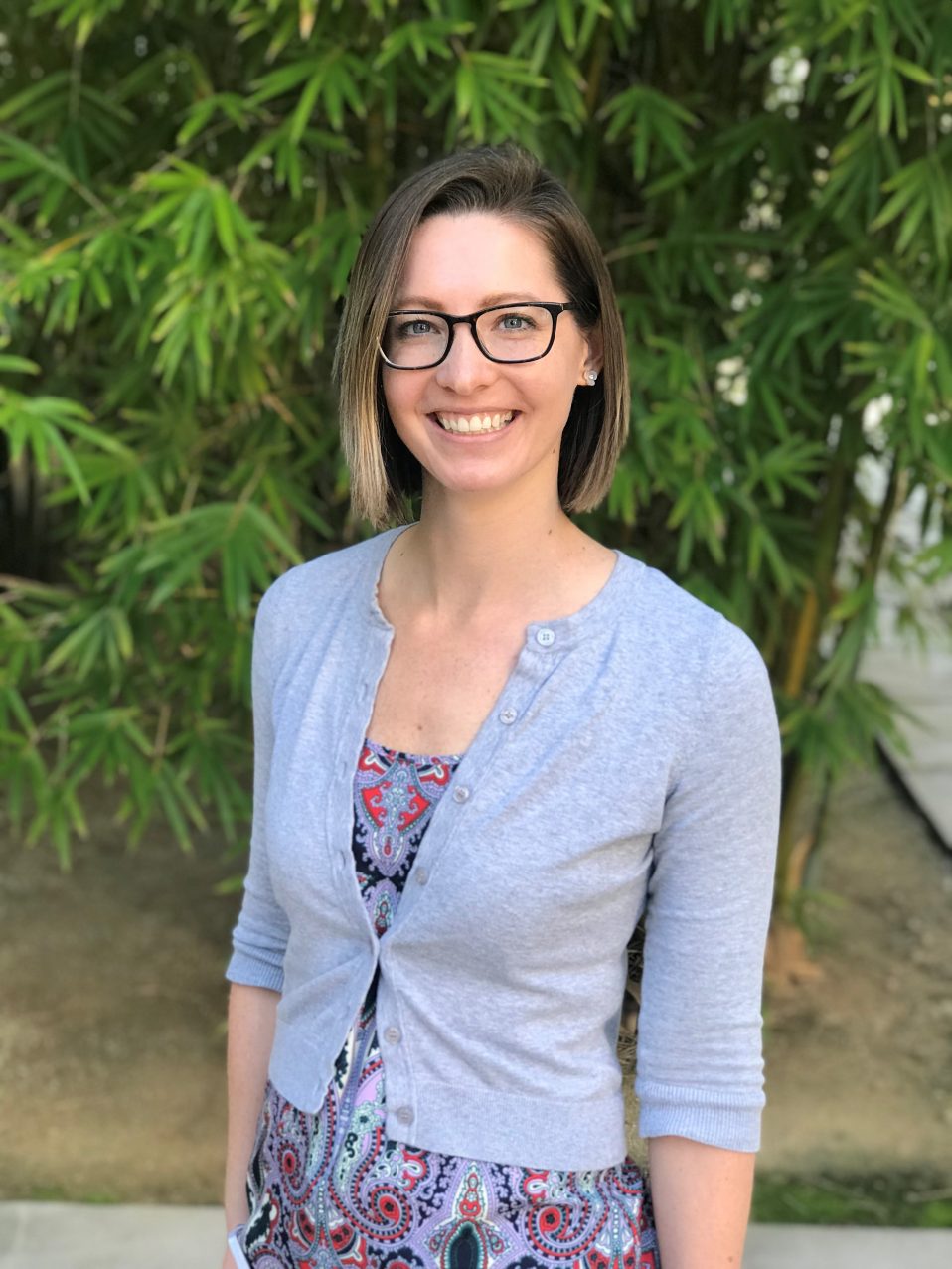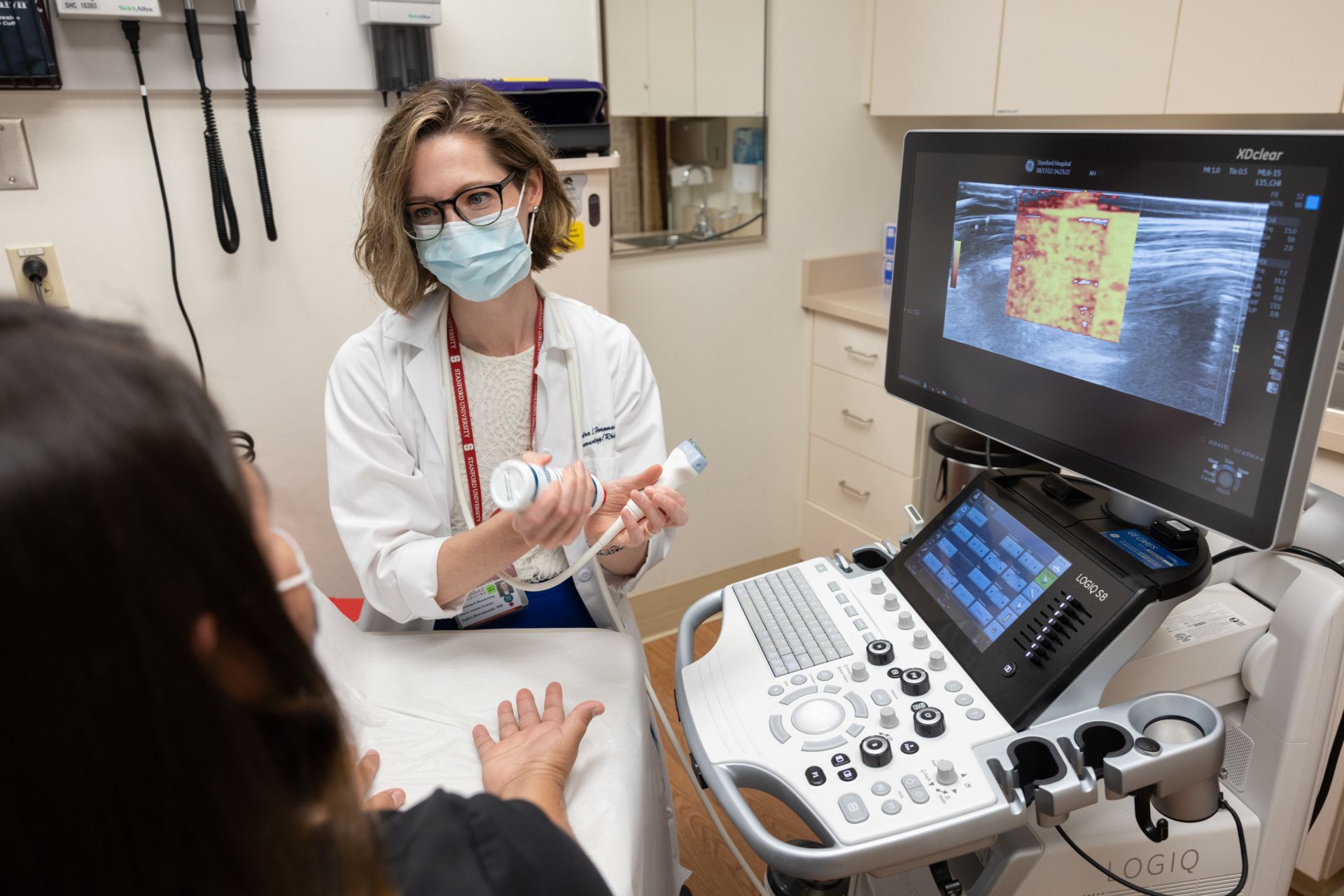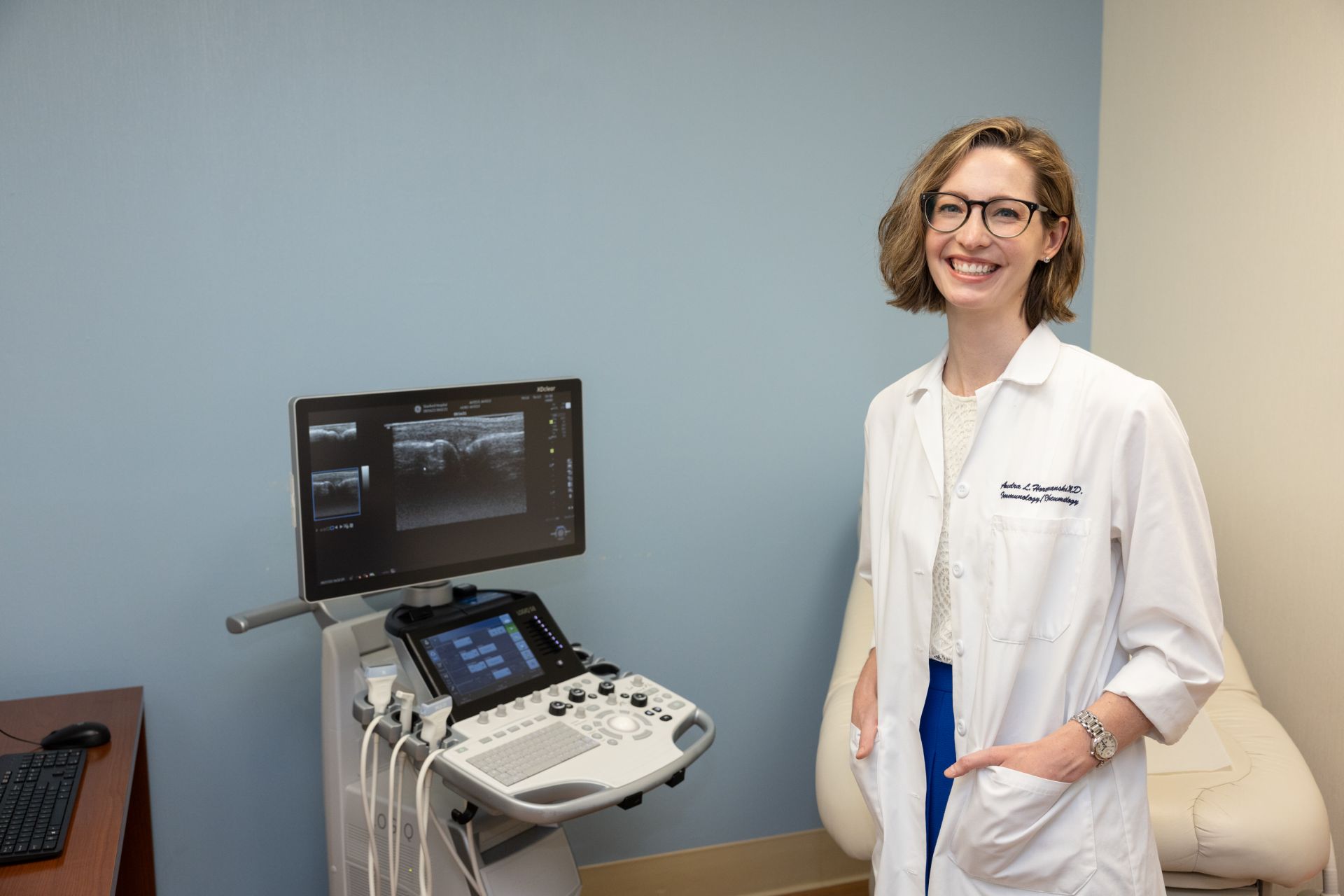Stanford Rheumatology Vasculitis Clinic
Restoring Normal Lives for Patients with the Rarest of Diseases

Stanford Rheumatology Vasculitis Clinic
Restoring Normal Lives for Patients with the Rarest of Diseases
It was 2013. Audra Horomanski was midway through an away rotation at Stanford as a medical student outside her home institution. That was when she encountered a young woman with newly diagnosed granulomatosis with polyangiitis, or GPA. The disease is one form of vasculitis, a rare condition characterized by inflammation of the blood vessels.
“The woman had a severe life-threatening ailment and made a quite significant recovery. That case really changed my whole trajectory and led to a growing interest in vasculitis during my internal medicine training and rheumatology fellowship,” says Horomanski, who earned her MD at Wright State University Boonshoft School of Medicine before completing postgraduate training at Stanford. Today, as a clinical assistant professor of immunology and rheumatology, she directs the Stanford Vasculitis Clinic.
A career in medicine, and rheumatology in particular, was a lifelong ambition for Horomanski.
“I’ve been interested in rheumatology since I was a kid. My sister, who’s three and a half years younger, has an autoimmune rheumatic disorder called juvenile idiopathic arthritis, or JIA. It went into remission when she was a teenager, but I spent a lot of my childhood going to pediatric rheumatology appointments with her and my mom. In fact, I recently came across a school project from first grade in which I answered the question, ‘What do you want to be when you grow up?’ My answer was, ‘I want to be a rheumatologist.’ It was spelled correctly, too! So, I’ve actually wanted to do this for as long as I can remember,” she says.

Audra Horomanski, MD
“I have a particular interest in patients who have vasculitis, which are multi system disorders that can be quite debilitating, and sometimes organ- or life-threatening. Easily the best part about being a rheumatologist is getting to see people recover and get back to their normal lives after presenting with serious illness. It’s great to witness patients achieve the maintenance phase, where they can get back to hobbies, vacations, going to look at colleges with their kids — all things that may have seemed very far out of reach when they were first diagnosed,” she explains.

Horomanski performs musculoskeletal ultrasound to evaluate for various rheumatologic and other joint musculoskeletal complaints.
Horomanski is a principal investigator in research supported by a grant from the Maternal & Child Health Research Institute. This aligns with her deep interest in how vasculitides affect young women, their fertility, and their decisions regarding if and when to have children.
“We’re actually talking about a collection of pretty heterogeneous diseases. Because vasculitides are all different, they affect very different populations. One of the vasculitides is Takayasu arteritis, for example. More than 80% of patients with Takayasu arteritis are women, and most of those women are under the age of 40, so it primarily affects people in their childbearing years. We don’t know enough about the maternal and fetal outcomes associated with pregnancy in vasculitis patients. A component of our current research involves the use of large databases to help answer such questions about these rare diseases,” Horomanski says.
Easily the best part about being a rheumatologist is getting to see people recover and get back to their normal lives after presenting with serious illness.
– Audra Horomanski, MD
Easily the best part about being a rheumatologist is getting to see people recover and get back to their normal lives after presenting with serious illness.
– Audra Horomanski, MD
Crossing organ systems
Rheumatology requires close collegial relations with other medical subspecialties, and Horomanski’s vasculitis work exemplifies that.
“Because blood vessels run throughout the body, these diseases can affect virtually every organ system. During the past two years, I’ve been able to create a network with colleagues in other subspecialties who can help with different manifestations of vasculitis. Whether it’s cardiology, nephrology, neuromuscular neurology, ophthalmology, neuro-ophthalmology, ENT, or pulmonology, I work with an expert in that specialty to treat patients. It’s been a big help to identify the providers in those divisions and departments who have an interest in vasculitis and who work well collaboratively,” she says.

Horomanski also has a particular interest in ultrasound and performs musculoskeletal ultrasound to evaluate for various rheumatologic and other joint musculoskeletal complaints in the Immunology and Rheumatology Clinic. In the past 20 years, specialists have recognized the value of vascular ultrasound to both diagnose and monitor large vessel vasculitis, and Horomanski received additional training in August 2022 to perform vascular ultrasound for patients with large vessel vasculitis.
“The best part about ultrasound is that it is noninvasive. Frequently these conditions need to be diagnosed by biopsy, and often temporal artery biopsy, which can be challenging to coordinate and schedule. And of course, it is an invasive procedure. If we can quickly and accurately diagnose people by ultrasound, it is a huge benefit to the patients,” she says.
As the clinic grows, greater involvement in clinical trials is expected, too.
Currently, Horomanski is working under principal investigator Matthew Baker, MD, assistant professor of immunology and rheumatology, on several trials related to IgG4-related disease and sarcoidosis, both of which can present with vasculitis. Horomanski, who did additional training during her fellowship on clinical trial design and management, is very interested in pursuing other vasculitis trials as the clinic continues to expand.
“That was one of the main objectives of this clinic. Stanford has a robust infrastructure to run these types of clinical trials, and we are looking forward to great things in the future,” she says.
Paying it back
Given that it was her own medical education that exposed her to vasculitis, it’s fitting that Horomanski would be passionate about an additional role as the Immunology and Rheumatology Fellowship associate program director.
“Part of the reason that I like this clinic so much is because it’s a teaching clinic. In addition to teaching courses at the medical school, we can expose all of our trainees to these extremely rare disorders in clinic and give them tools to treat these patients when they encounter them,” she says.
Working with severely ill patients is extremely stressful, so how does Horomanski deal with that?
At the start of the COVID-19 pandemic, she and her husband were searching for an activity that was safe, could be done outdoors, and allowed for social distancing. That led them to take up ceramics.
“I mostly do wheel throwing, which is super-therapeutic. You can completely zone out, and the clay feels really nice. You don’t have to think about anything. It’s great,” she says.
Patient Volume Increases at the Stanford Rheumatology Vasculitis Clinic
Since 2020, the number of vasculitis patients seen at the Stanford Rheumatology Vasculitis Clinic has doubled. As of July 2022, the clinic had close to 150 unique vasculitis patients who were being seen regularly. On average, Horomanski sees about three new vasculitis consults a week.

“Part of the reason that I like this clinic so much is because it’s a teaching clinic. In addition to teaching courses at the medical school, we can expose all of our trainees to these extremely rare disorders in clinic and give them tools to treat these patients when they encounter them.”
– Audra Horomanski, MD
Referrals come from throughout California, Oregon, Nevada, Hawaii, and even the East Coast, but most patients live in California’s Central Valley, where providers do not have extensive experience with these rare illnesses. Horomanski tries to share care with each patient’s local rheumatologist, which allows the patient to see their nearby physician, while also getting the care they need from a large academic center.
